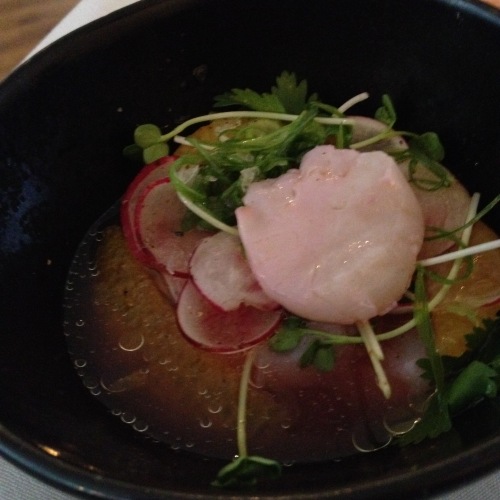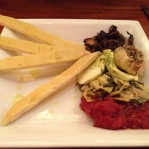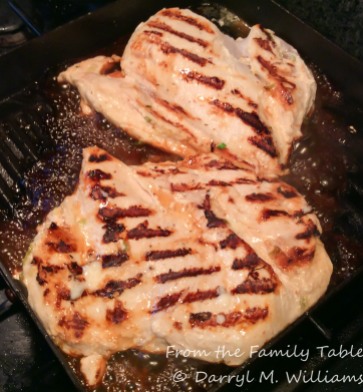Last night for our belated anniversary celebration we went down to the Plaza for drinks and dinner. We are always game for places we have never been. Last night was a bonanza.
Our first stop was the Inn on the Alameda. As its name suggests, this smallish collection of casitas is on the Alameda, but it is far enough away from the busy Plaza that it is relatively quiet. They have just recently started serving meals, and their bar is reputed to be outstanding. We lucked into arriving just as their wine and cheese happy hour began. We both got a glass of wine and a plate of cheese and crackers. Then we headed out to the beautiful courtyard, and sat under a huge crabapple tree. The adobe walls, vines, flowers, and coolness made it a place hard to leave. Besides that, others were enjoying drinks and quiet conversations, unlike the boisterousness that is so common on the Plaza.
Soon enough, it was time for our dinner reservation at Radish and Rye, a restaurant that has only been open for five weeks. It turned out to be a find. In fact, in my humble opinion, I think that it is serving up the best restaurant food currently available in Santa Fe.
The restaurant is in space that formerly housed La Ristra, one of the standbys of the local dining scene but closed because of the death of its owner. The space has been totally redone: light, bright, and airy with bold artwork and interesting lamps and accessories on the walls and side tables. The cocktail and wine menus are presented in wooden books with the restaurant name and logo burned into them with a laser – very stylish. The napkins are bar towels, reminiscent of Rich Table.
The wait staff is very friendly and helpful without being overwhelming, and they are all quite knowledgeable about the menu. The kitchen crew is hard working, and you can watch them from the front dining room.

The “Rye” in the name of the place recognizes their emphasis on high-quality bourbon. You can order some rare brands neat, but for the rest of us, it is easier to choose a blood orange old fashioned or, as I did, an “Abuelito” (little old grandpa) Manhattan. The Manhattan is served in a beaker fuming with what I guess is a last-minute blast of liquid nitrogen. The wine list is relatively small, but it is well-chosen, even if a bit pricey.

Abuelito Manhattan

Blood orange old fashioned
Of course, the main attraction is the food. It is billed as Contemporary American, but it is far more eclectic than that: fried green tomatoes and fall-off-the-bone pork ribs from the South, ceviche from the Southwest, beet salad and grilled cauliflower steaks – perhaps representing California?, gorgeous salmon filets from the Northwest, and a nod to France with the eponymous radishes served with fresh butter and sea salt. .
Notable in their absence were the green chiles that make nearly every other menu in town as well as the enormous elk chops meant to appeal to the many Texan tourists of summer. That in itself is refreshing, as the most famous local restaurants have maintained old menu favorites at the expense of losing their creativity and currency.
Unfortunately, the Yelpers are already complaining about portion size. They don’t seem to get the concept of small plates (as opposed to steaks that will feed a family) that has become so popular in San Francisco, Los Angeles, and New York.
You can choose from “large plates”, regular entrée-sized servings or “small plates” meant to be shared. I guess, if you had a Yelper/Texan appetite, you could order from both parts of the menu, but we chose a number of small plates. Here’s what we ate:
Sea scallop ceviche: Sea scallops arrive in a little ramekin, bathed in the citrus juice they have been “cooked” in and with golden droplets of a finishing oil flavored with jalapeño. Micro-greens complete the dish. It is delicious.

Fried green tomato: This Southern classic is prepared in a way not usually seen with fried green tomatoes. The tomatoes are lightly fried in a tempura batter, and between the slices is a tasty dollop of another Southern classic: pimento cheese. I have previously written about pimento cheese, April 17, 2014. This preparation raises a standard ladies luncheon staple to a new level.

Ham hock croquette: Ordinarily one doesn’t think of ham hocks as delicate, but these come as light croquette, breaded and fried to just the right color and temperature. A whole grain mustard for dipping and pickled shallot complete the dish.
Unfortunately I forgot to get an image. I was too busy admiring the plate
Duck rillette: What could be richer than duck confit poached in duck fat, then chopped finely and mixed with still more duck fat? The dish comes in a little ramekin to be spread on the accompanying razor-thin crostini. The pickled baby turnip makes a perfect foil for all of that richness.

Grilled cauliflower: Florets of the vegetable are lightly charred and then combined with pecans and capers, then topped with lemon butter and sage.

Back ribs: The meat literally falls off the bone it is so tender, and it has the smoky taste you expect from the Carolina-style glaze.
Roasted beet: Beet salad is perilously close to becoming cliché in contemporary American cuisine, but this version pulls it out. The beets pair nicely with the sour sweet of balsamic vinegar, and the walnuts, lovage, and blue cheese complement the other ingredients.

Radish and lemon butter: With a name like Radish and Rye, the restaurant had to offer a radish dish, and this French-style plate of quartered perfect radishes served with sea salt and lemon butter did the trick.

For dessert, we had a panna cotta with stone fruit topping and a pecan pielet topped with a candle to honor our anniversary. Truly an evening to remember.

















































































